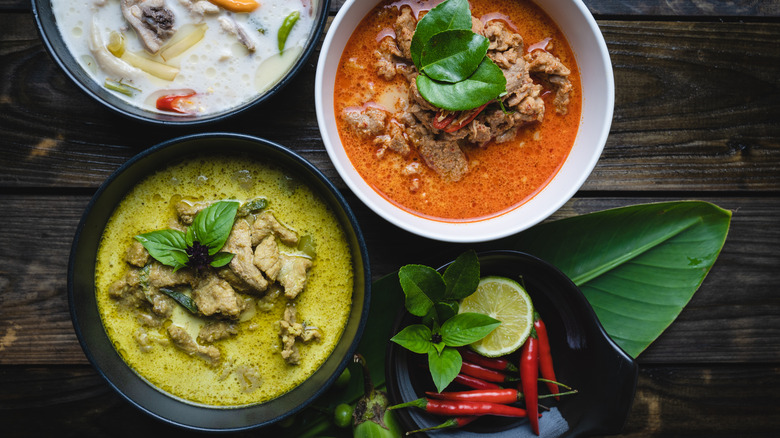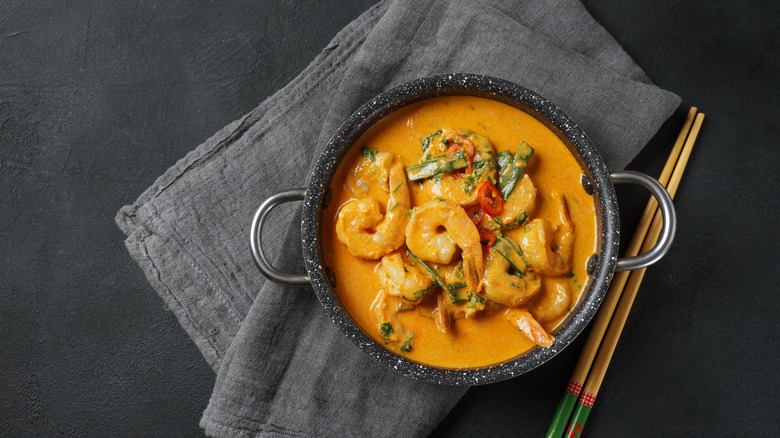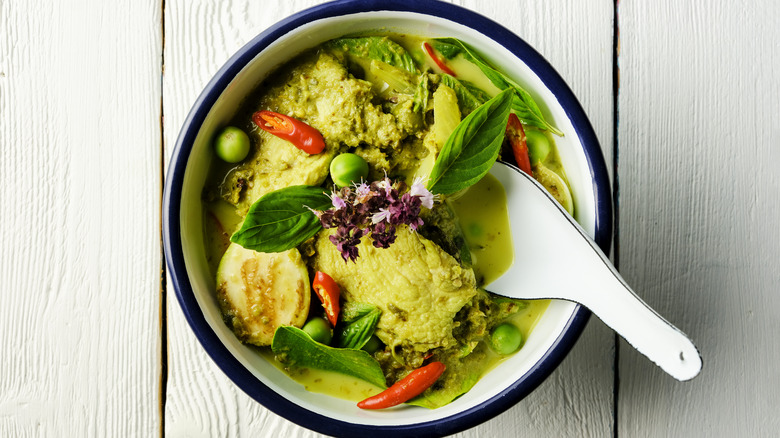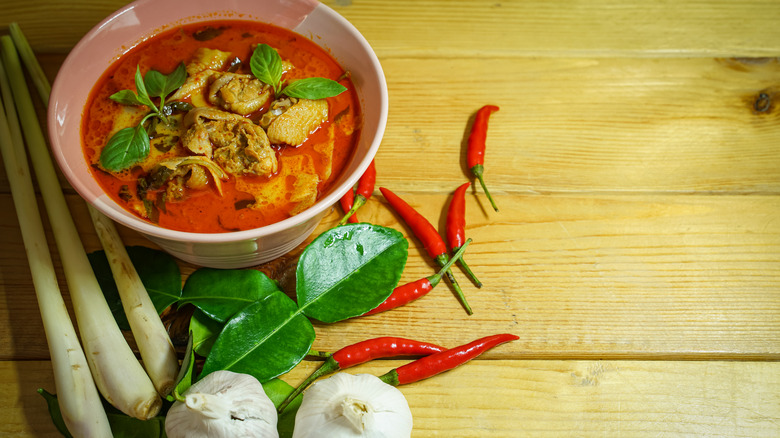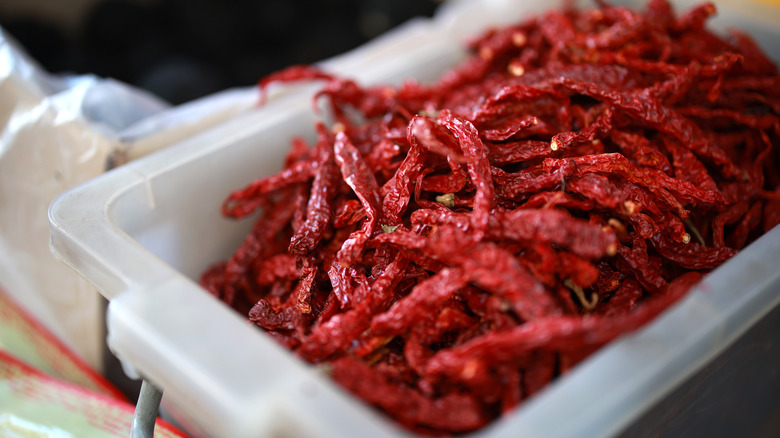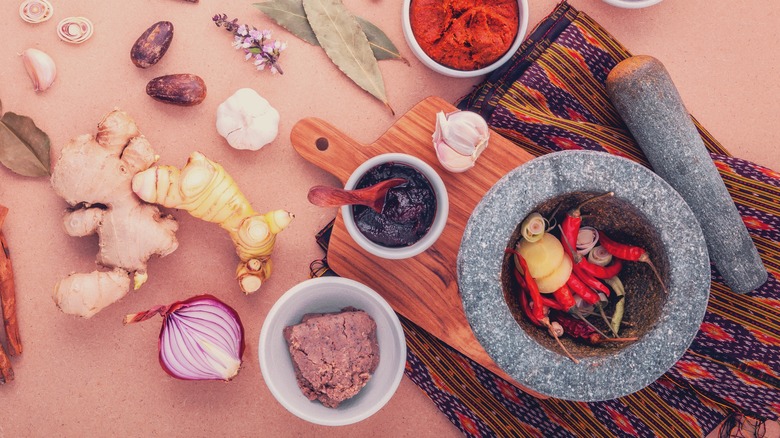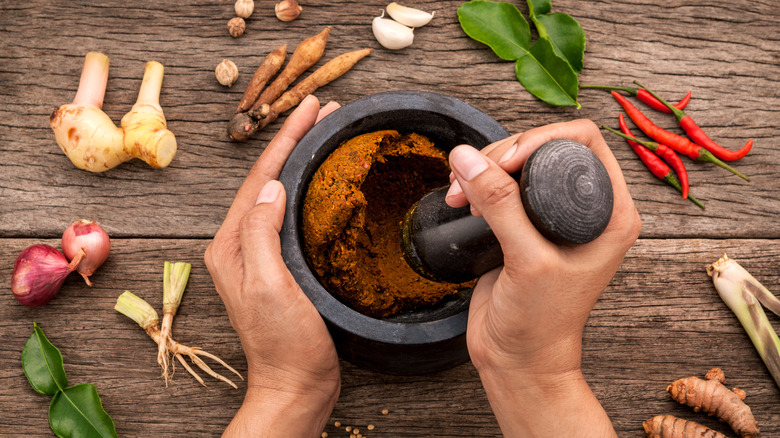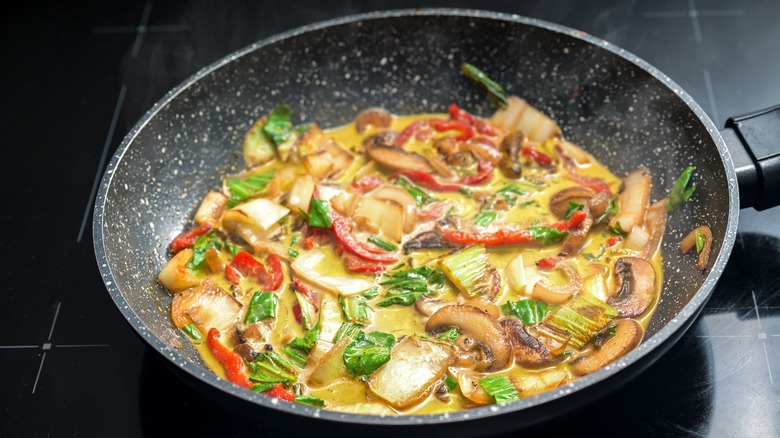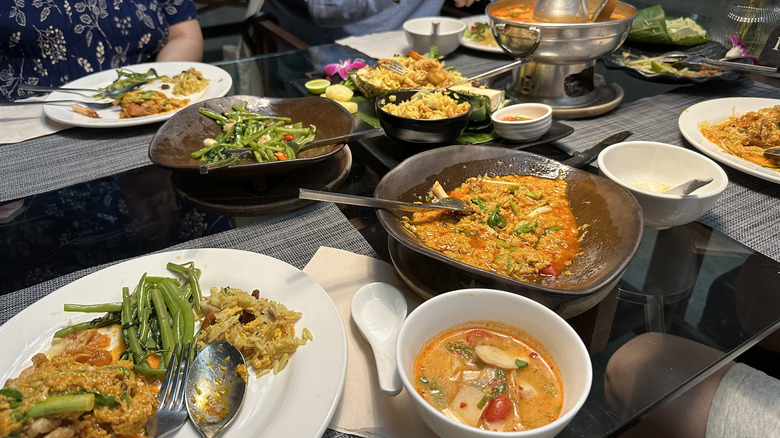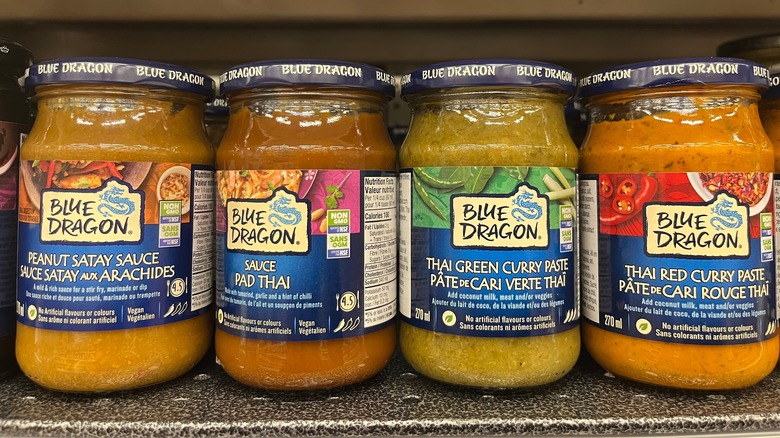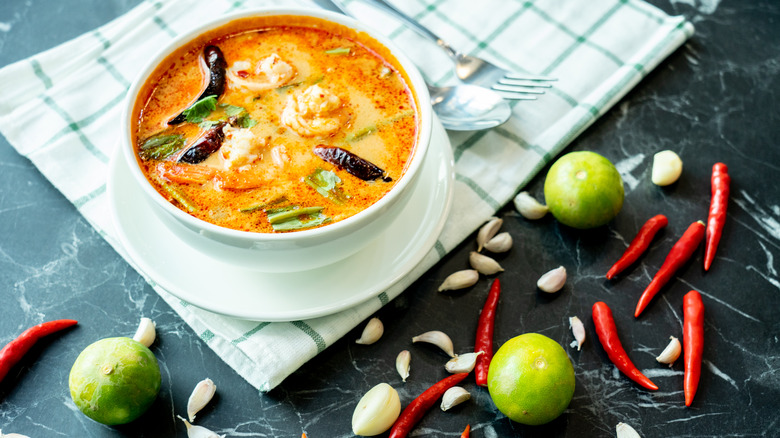Thai Red Curry Vs Thai Green Curry: Everything You Need To Know
Today, we're diving into the dazzling world of Thai curries, bringing you the ultimate flavor-packed showdown between the red and the green. Perhaps you've been wondering exactly what the difference is between Thai green curry and Thai red curry. Maybe you've tried both but still aren't sure and would like to know more next time you order one at a Thai restaurant. Or it could be that you're eager to make Thai curry paste from scratch at home but aren't sure which to start with. Whatever the reason you want to know more, we have the goods.
First up is Thai red curry. With its bold red hue that comes from dried red chilis, it's often touted as the spicier option, but is this true? Then we have its vibrant counterpart, Thai green curry. Green by name, it is far from novice in flavor. But what sets the two apart? Why choose red over green or vice versa? There's a lot of ground to cover, but we have the information you need to untangle the mystery.
We're about to take you on a journey through the heart of Thai cuisine. While there's much more to Thai food than just red and green curries, they are involved in some of the best-known Thai dishes worldwide. If you want to know more about the nation's cuisine, this is a solid place to start. We're about to tell you everything you need to know about Thai red curry versus Thai green curry.
What is Thai red curry?
Thai red curry, known as gaeng phed in Thai, has deep roots in Thailand's culinary heritage. Thai curries have been cooked for hundreds of years with many regional variations. However, in 2002, the country's government created the Global Thai Program to promote Thai restaurants worldwide. With this program came regulated recipes for red and green curries, which is part of the reason why these are the most popular and well-known options. That's not to say that red curry didn't exist until 2002, but that's when it became more standardized and pushed as a common option outside of Thailand.
At the heart of Thai red curry lies its paste. It's crafted with a blend of aromatic herbs and spices, along with plenty of red chilis. This paste is then mixed with coconut milk to create a velvety, creamy texture that's as indulgent as it is comforting. The coconut milk not only tempers the spice but imparts a sweet undertone. It's added in fairly large quantities that make red curry much soupier than many people in the West expect their curries to be, but this is part of what makes it so delicious.
The beauty of red curry lies in its versatility. Sauce aside, it can contain any ingredients of your choosing: succulent meats, fresh seafood, or an array of vibrant veggies. It's generally served with sticky rice (for perfect rice, check out common mistakes to avoid when making rice) to bring you a filling, warming meal.
What is Thai green curry?
Thai green curry is similar to Thai red curry, though certainly not identical. In Thai, it's known as gaeng khiao wan, which translates to sweet green curry. Like red curry, it was a prominent export as part of the Global Thai Program. This program of culinary diplomacy brought many more Thai restaurants to other parts of the world, and with them a standard recipe for green curry.
Like red curry, green curry starts with a curry paste. While many home cooks in the U.S. buy curry pastes from the store, a truly great Thai green curry needs a curry paste made from scratch. It has similar ingredients to red curry paste — including herbs, spices, and other aromatics — but uses fresh green chilis in place of dried red chilis. This is what gives this curry its green hue, as opposed to a red one. Again, this paste is mixed with coconut milk, and plenty of it, so it has a soupy consistency.
You could never mistake a green curry for a red one when looking at it. The colors are just too different from one another. However, there are a lot of similarities between the two, so it's understandable that the line that distinguishes them often needs more explaining.
Do they smell the same?
The aroma of food makes a difference in how we enjoy it, so it's natural that you might be wondering what red curry and green curry smell like and how, if at all, their fragrances differ. Thai red curry emanates a rich, savory warmth that fills the air with notes of various spices. The scent is a mixture of red chilis, garlic, lemongrass, galangal, and an assortment of other aromatic spices. You'll also get some sweet, coconutty notes from the coconut milk.
Thai green curry has a slightly fresher and more herbaceous profile. The dominant aromas include green chilis, cilantro root, and makrut lime leaves and peel that combine to create a zesty bouquet. Imagine the crisp, citrusy notes mingling with the sweet and creamy essence of coconut milk. Some people describe green curry as more aromatic than red curry, although both of them pack a punch.
While both curries have notes of coconut milk, their differing spice profiles shape their scents. Thai red curry has a deeper, spicier aroma, while Thai green curry has a more lively, herbal fragrance. So, no, they don't smell the same. If you smelled both types side-by-side, you'd be sure to know the difference. That said, they still have a lot of similarities, so if someone was whipping up a Thai curry in the kitchen and you didn't know whether it was red or green, it would take a well-trained nose to smell the difference right away.
Which one is spicier?
Here's a common question for you: Which Thai curry packs the bigger punch — red curry or green curry? Now, don't let the hues fool you. It's a recurrent culinary misconception that Thai red curry is the undisputed champion of spice. Why? Well, the color red often sparks associations with heat and intensity in the world of food. But in the lively realm of Thai curries, the truth might just stir things up a bit.
Surprise, surprise! In traditional Thai cuisine, it's green curry that reigns supreme in the spice department. The green tint might seem deceivingly calm, but here's the spicy secret: Thai green curry gets its heat from fresh green chilis, including fiery bird's eye chilis. These little green powerhouses bring a spicy kick that outshines the dried red chilis found in red curry.
Of course, this is also a generalization because you will find regional variations in Thailand. For instance, if you eat a green curry in Southern Thailand, you can expect it to be significantly spicier than the same type of curry found farther north in Bangkok. It's also not unheard of for some Thai restaurants in the U.S. to give you an option of spice levels with red and green curries. This means you could ask for your green curry to be milder than standard or your red curry to be hotter than standard. So, under normal circumstances, green curry is spicier than red, but there is some room for nuance.
How do the ingredients differ between red and green Thai curry pastes?
There are some ingredients that you'll find in both red and green Thai curry pastes. Lemongrass is one of those you'll find in both pastes. It acts to introduce citrusy, herbal notes, providing a fresh and bright flavor profile. Then, there's galangal, a root similar to ginger, which is a key component that imparts an earthy warmth. White peppercorns add some bright yet earthy notes to curry pastes. And, no curry could do without garlic. Shallots are utilized to provide a mild, sweet onion flavor, adding a layer of savory depth to the curry paste.
You'll also find fermented shrimp paste in both kinds of curry pastes to bring an umami undertone for depth and complexity. However, this may be omitted or subbed with another umami ingredient to make curry pastes vegetarian. Cilantro roots are included for their fresh and slightly citrusy flavor. However, cilantro stems can be used in their place. Finally, makrut lime leaves and zest contribute a peppy, citrusy brightness.
However, there are ingredients found only in red or green pastes. Red curry paste includes dried red chilis (usually a blend of mild ones and spicy ones). Green curry paste doesn't include red chilis but instead uses fresh green chilis. Plus, green curry paste may get additional herby notes from fresh Thai basil. Coriander seeds and cumin seeds make the green curry paste more fragrant, though some also use them in certain red curry pastes.
Do you make red and green curry paste the same way?
Now that you know more about the differences in ingredients found in red and green Thai curry pastes, you might be wondering if they're made in the same way. Well, the simple answer is "yes." Despite their slightly different ingredients, the method for making the pastes is essentially identical.
There are two main ways of making Thai curry paste: the traditional way and the quick way. If you want to follow the traditional route, you'll need to be armed with a mortar and pestle. Each ingredient — from fiery chilis to fragrant lemongrass — has its turn being pounded to a uniform paste. This timeless method, although labor-intensive, is revered for creating pastes with unparalleled depth and authenticity.
However, in our fast-paced world, home cooks sometimes opt for the quicker path to curry bliss: a blender or a food processor. While this approach lacks the poetic charm of the mortar and pestle, it delivers a convenient solution for those craving a swift yet flavorsome curry paste. Toss in the ingredients, hit the blend button, and voila — a paste is born. However, it's essential to note that this method, though speedy, sacrifices a bit of the authenticity and depth inherent in the traditional approach. An immersion blender is the best tool for small batches, but an upright blender or a food processor works for larger batches of paste.
How do you make the pastes into a curry?
There are a range of slightly different methods for turning curry paste into a Thai red curry or a Thai green curry, but the process is fairly similar across the board. And, there's really no difference between how you cook a red curry and how you cook a green curry once you've got the paste sorted.
You always start out by cooking the paste. Since the paste contains raw aromatics — such as garlic, ginger, and shallots — you want it to cook thoroughly before adding liquids or other ingredients. If you skip this step, it simply won't taste right or have the depth of flavor that you'd expect. After the paste has cooked until the color has darkened and it smells wonderfully aromatic, you add your protein or veggies, depending on the type of curry you're making. The protein could be meat, seafood, or vegetarian proteins like firm or extra firm tofu, depending on your preference, or tempeh or seitan. Vegetables that work well in Thai curry include eggplant, snow peas, zucchini, broccoli, mushrooms, and even sweet potato.
Once the proteins or vegetables have cooked somewhat, it's time to add the coconut milk. The result is a velvety concoction where spice meets soothing sweetness, a hallmark of Thai curry perfection. Some recipes also include water or stock. The last step is to simmer everything until the protein is cooked through and the flavors have melded.
Can you order them in restaurants?
If you want to have a Thai curry without the hassle of making one yourself (or you just want a better version than you could make at home), you might be wondering if they're available in restaurants. Well, you'd be hard-pressed to find a Thai restaurant that doesn't have them on the menu. Most Thai restaurants have both green and red curries on their menus, along with other popular Thai curries, such as yellow curry, which features tumeric for flavor and coloring, and panang curry.
What about restaurants other than Thai restaurants? You may find a Thai curry or Thai-inspired curry in a restaurant that sells a range of cuisine, but it's by no means a given. Plus, it just might not be as good as one that comes from a Thai restaurant. So, it wouldn't necessarily be our first pick for where to eat Thai curry, but you might get lucky.
The choice between Thai red curry and Thai green curry is largely a matter of personal taste. However, green curry is said to be the more popular of the two. So, if you're not sure which to have and spice levels aren't a major consideration, then a green curry could be a good place to start, with its creamy consistency, aromatic notes, and fiery kick.
Can you buy them ready-made?
Making a Thai curry from scratch, including the paste, will give you the tastiest results, whether you choose red or green. However, most of us don't have the time for that, particularly on a weeknight. So, what are your ready-made options? Luckily, you have a range of choices. Most fit into one of three categories: ready-made Thai curry pastes, ready-made Thai curry sauces, and microwave Thai curry meals.
For those who seek an authentic touch, ready-made curry pastes are your kitchen companion. These jars of flavor-packed magic bring the essence of Thai spices, herbs, and aromatics right to your fingertips. These pastes offer a shortcut without compromising too much on authenticity. If you're looking for a quicker solution, ready-made curry sauces are a convenient choice. These pre-prepared sauces typically blend the essential flavors of a Thai curry into a convenient bottle. While they may not boast the same depth as curry pastes, they're a swift alternative for those moments when time is of the essence.
Or, for the ultimate convenience, Thai curry microwave meals take the crown. Available in both green and red versions, these ready-to-eat delights bring the bold flavors of Thai curry straight to your table with minimal effort. While they might not match the nuanced taste of a freshly prepared curry, they're the go-to option when time is scarce and hunger is calling.
Do they cost the same?
In most Thai restaurants, you'll find that the cost of Thai red curry and Thai green curry is usually the same. Restaurants typically price these dishes similarly, reflecting the equivalent effort and ingredients required to prepare both versions. This parity in cost makes it easy for diners to choose their preferred flavor without being swayed by a significant price difference.
Similarly, when it comes to purchasing red and green curry pastes from the same brand in a supermarket, you can expect them to be priced comparably. The pricing strategy often considers the production costs and ingredients, ensuring that consumers don't face a significant price distinction between the red and green variants.
For those adventurous souls who enjoy crafting Thai curries in their own kitchens, the cost of making red curry paste and green curry paste is also quite comparable. While green curry paste may include a couple of additional ingredients, making it marginally more expensive, the overall cost remains in the same ballpark. This cost equilibrium encourages home cooks to explore both red and green curry variations without feeling a substantial dent in their culinary budgets. So, whether you're dining out or creating Thai masterpieces at home, you can savor the diverse world of red and green curries without breaking the bank.
